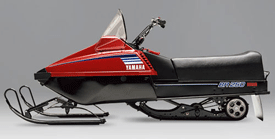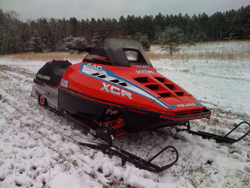
At the height of the vintage snowmobile era in the late 1960s and early ’70s, builders and brands were coming and going, some buying and building other brands while trying to stay afloat in an insanely competitive environment.
And no company made a bigger splash or packed more activity into fewer years than Dauphin Industries of Grand-Mere, Quebec.
Organized in 1969 by Ovide Desaulnier, the fledgling manufacturer was one of literally dozens to produce a copy of the classic Ski-Doo.
With a Hirth industrial engine perched atop a steel tunnel over bogie wheels and a molded rubber track, there really wasn’t much to differentiate the 1969 Dauphin from most of its competition except for its sleek styling with a distinctive royal purple and white color scheme, and a disc brake as its one advanced feature.
Dauphin is French for dolphin, and the company adopted the aquatic mammal that had been popularized by the “Flipper” television show as its identity, using a dolphin logo liberally on its sleds. But unlike most other fledgling sled manufacturers, the company quickly built a respectable distribution network across the North American Snowbelt on both sides of the border.
The 1970 Dauphin was available in two series: standard models had manual start single-cylinder engines and single headlights, while DeLuxe models had either twin-cylinder engines or electric start if not both, with dual headlights and a white belly pan. The company was one of the first to adopt the new Eastern drive clutch, replacing the Power Bloc found in the earliest Dauphins, and dependability and ease of operation were stressed as key selling points.
In addition to dealerships handling the Dauphin brand, the company also be-came a private brand supplier to J.C. Penney, one of the leading chain stores of the day. Known as the Penney’s Manhandler, only decals differentiated the machines from Dauphins.
The rapidly growing company completed calendar year 1970 by introducing the Dauphin Flipper, the company’s version of the short-lived Chimo mini-sled built by Somovex of L’Isletville, Quebec. That sled was also being sold by Penney’s as the Mini-Manhandler. Somovex was a parts supplier to Dauphin, and Dauphin apparently acquired assets of Somovex following that company’s bankruptcy in December 1970. But the Flipper never entered full production.
The 1971 Dauphins got a mild restyling but no significant changes. A select number of Grant’s stores – another big dry goods retail chain – also became Dauphin dealers. The mini-sled was continued for Penney’s, but with the name changed to Snow Tamer. The company also built a series of Sno-Chief models for Dufrane Motor Distributors of Malone, New York. The 1971 and ’72 Sno-Chiefs were rebadged Dauphins built in Grand-Mere, with the ’71s differing little from the Dauphins except in color. But the 1972 Sno-Chiefs had JLO power and a different track.
B.C.R. Auto-Neige of St. Henedine de Beauce, Quebec, was also a customer. Its 1972 Super Star sleds were bright blue Dauphins with Kohler or CCW power and a few other minor changes.
According to reports from the day, Dauphins were not particularly fast or smooth riding, but they were tough, relatively dependable and handled pretty well for what they were. Janice Brewer, a western New York teenager when her father brought home a new Dauphin 240E, remembers that she and her sister rode it for several seasons.
“We had a lot of fun on it,” she said. “We had no problems making it operate. [We] didn’t have any problems steering it.” That particular machine was fully restored a few years ago by versatile vintage authority Mark Elwell of Arkport, New York, and is now owned and exhibited by Cindy Mayka of Syracuse, New York.
The Ripples Fade

Like most small snowmobile manufacturers, Dauphin Industries was undercapitalized for the difficult and cash-intensive sled business. The company was badly hurt by slow payment for the Penney’s sleds, delivery of which fell behind schedule due to slow parts deliveries to Dauphin, and then by cancellation of Penney’s orders for thousands more snowmobiles.
Dauphin went bankrupt in 1972 and the dolphin sled died. Penney’s cleared its inventory during the 1973 season, with Manhandler 240E prices slashed from the original $1,160 to $799. Pull start 292 single cylinder models were cut to $560, and Snow Tamers dropped to only $388.
Dufrane Motors purchased the Dauphin tooling, fixtures and parts at the bankruptcy auction and moved them down to Malone. The sled re-emerged as an improved Sno-Chief and lasted through a final 1977 prototype, but that’s a tale for another time.
Ultimately the Dauphin was just one more flop in the long line of Ski-Doo clones that didn’t make it. But in its four-year existence, Dauphin Industries and its dolphin sled made more waves than many brands that lasted longer than they did, and that makes the nearly forgotten Dauphin one of the more interesting and important brands of days now long past.
Editor’s Note: Every Snow Goer issue includes in-depth sled reports and comparisons, aftermarket gear and accessories reviews, riding destination articles, do-it-yourself repair information, snowmobile technology and more. Subscribe to Snow Goer now to receive print and/or digital issues.





I positively remember riding this sled when I was 15yrs. young! I am now 65 and still riding. My best friend had a 115 he bought from his uncle. The 24hp. was awesome! His uncle let us use it here and there. The 24hp was known for twisting and breaking the front shaft that had the cogs for the track on it. When Dauphin went out of business he became a Sno-Prince dealer. Boy did I work hard to pay for my new sled! It was an 18hp 338cc 1cyl. Hirth engine. $700.00 +3% sales tax! Back then we actually could count on getting snow. Now I have to go all the way up to Quebec to have any real fun. I ride Ski-Doo now but they have “vintage sled” events all the time up there. Talk about a trip down memory lane.